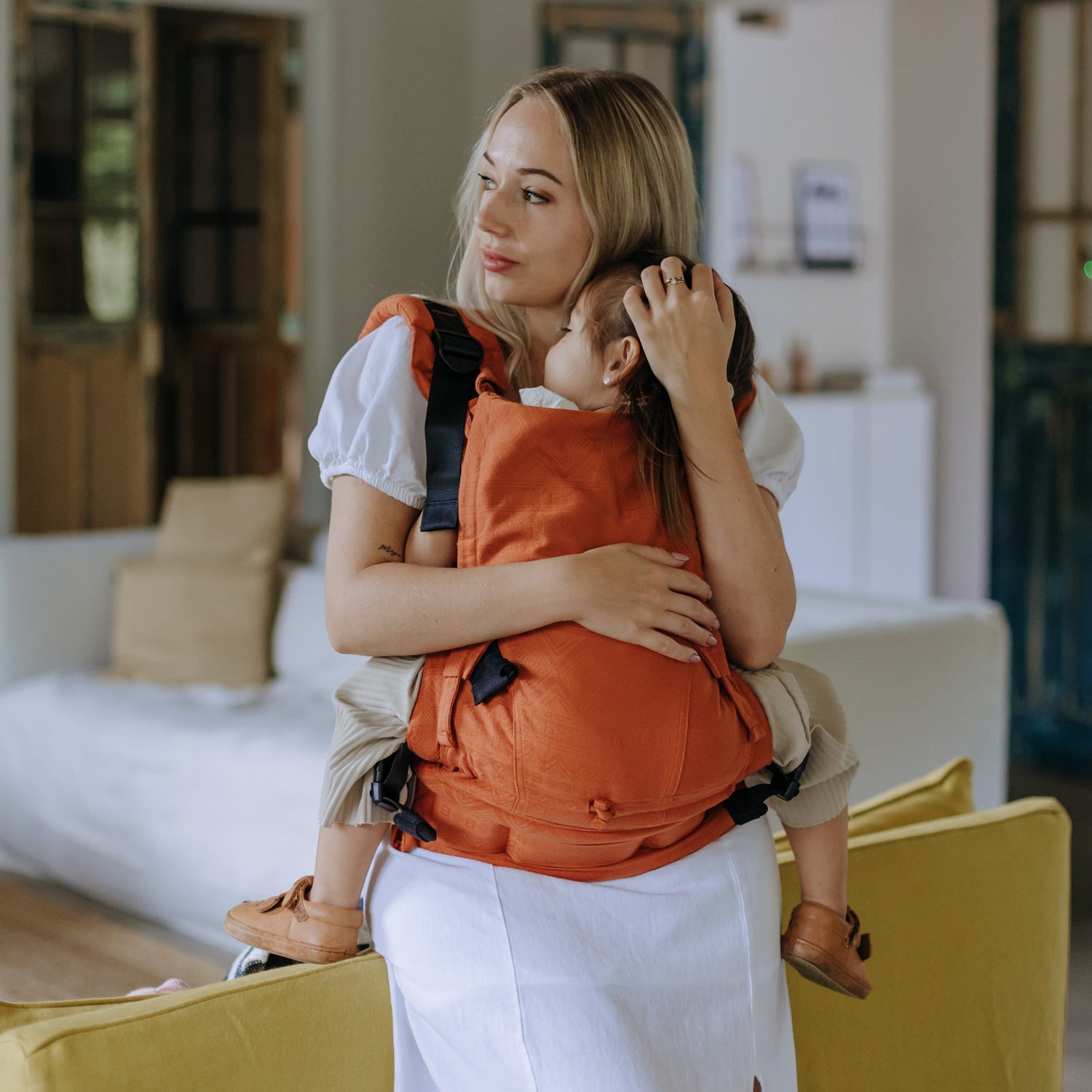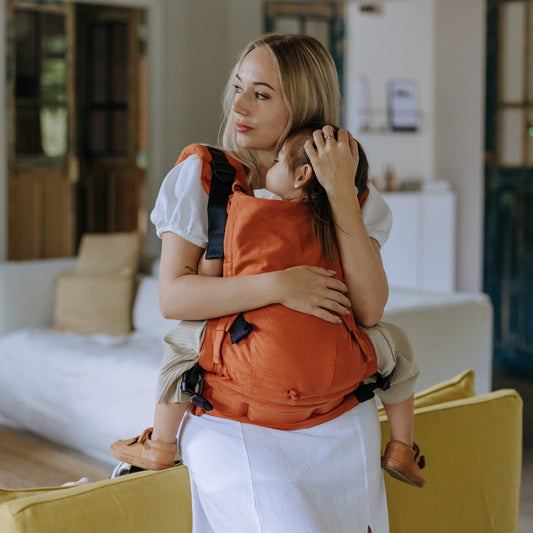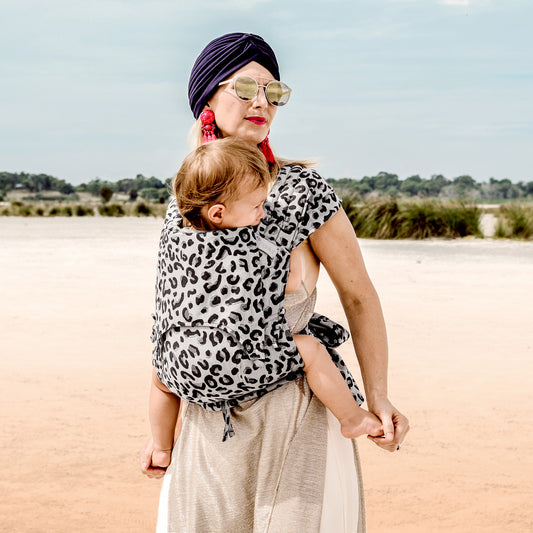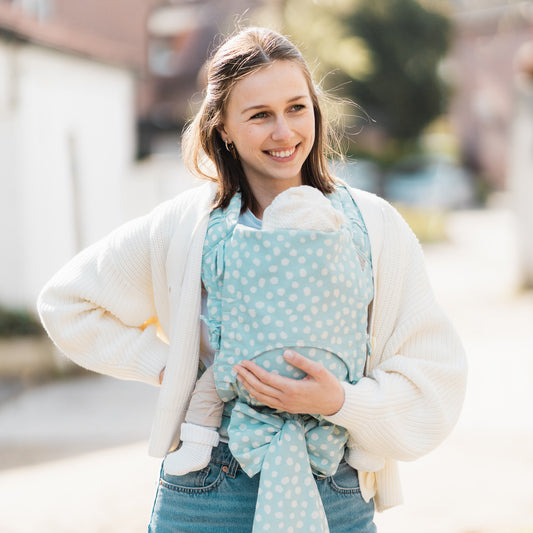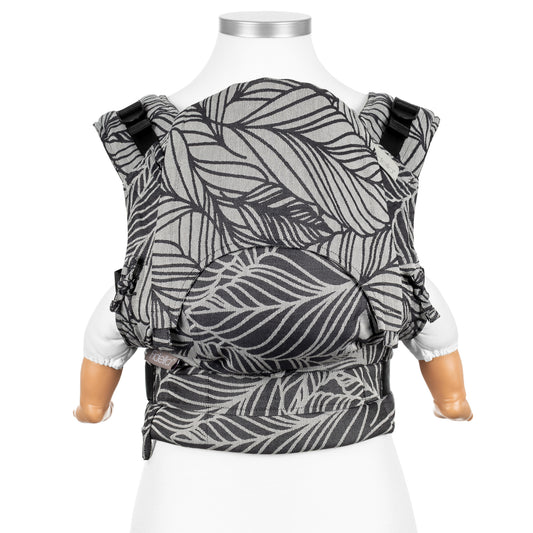Origins of baby carriers
History of baby wearing
History of baby wearing has its origin in phylogenetic backgrounds. In former times human beings lived together in hordes or family groups. They were constantly on the move in search for food and safe resting places. The offspring was always taken with one of the members of the family - carried close to the body. From this results a phylogenetical conditioned baby wearing tradition, which was spread out worldwide and is still practiced in several societies.
Even today newborns and babies show the typical characteristics for “being carried”: grasp reflex, squat reflex aso.
Baby wearing still supports the motor, sensorical and cognitive development of a child.

Africa
Kanga
A Kanga is a rectangular, African wrap made of cotton, with a width of 1 m and a length of 1,50 m. It isn`t only used for transporting children, but also as garment. The wrap isn't woven in a special technique. It is used in the regions Tansania and Kenia (East Africa).
Characteristics: A Kanga always has a woven frame (Swahili: pindo) and an aphorism (jina) in the middle field (mji).
The piece of cloth is placed on the back of the child and then tightened at the upper and lower edge. The strands are twisted into each other to fix the Kanga in front of the belly.
Asia
Mei Tai (背带) | China
The Mei Tai - Meh Dai (Cantonese) or Bei Dai (Mandarin) - is a traditional baby carrier originating from Asia (China).
Sometimes, the Mei Tai is called “origin of all baby carriers”. Originally, it was made of a rectangular piece of fabric, the seat squab, with four straps at each side. The upper strands were used as shoulder straps, the lower strands as a hip belt.
Modern designs of the Mei Tai have different forms: American Mei Tais are rectangular and often rounded or sloped at the upper edge. European designs normally are more curved with a rounded shape. Darts at the back panel offer the possibility to create a suitable pouch. A lot of baby carriers are adjustable individually, e.g. in height at the back panel or in width at the strap between the hollow of the knees. Most of them have an additional head- or neckrest which can be used as sun protection or hood.
Mei Tais can be used as front-, hip- and back carriers. They are similar to wraps and almost usable for all body sizes.
Onbuhimo | Japan
The Onbuhimo is a baby carrier originating from Japan.
The name Onbu-himo is composed of 2 different words:
Onbu means “pickaback” or “carrying on the back” and himo is the Japanese word for “cord, pimp or string” which is flat with a width of 7 -8 cm.
The traditional Onbuhimo was made of a piece of cloth entwined with a string.
The Japanese had to reconcile work and parenting for a long time. Normally, children spent their time with their parents while they were working. Most of all children were carried on the back while their parents were working, e.g. on the rice paddies. Not only mothers but also grandmothers or siblings carried their smaller brothers and sisters on their back while parents were working. This was the most practical way to carry children for centuries.
Carrying children in the kimono or himo was common in Japan for centuries. This changed in the 1930s during the industrialization when more commercialized baby carriers released. First manifestations were like a Mei Tai (Mei Dai (cantonese)) or Bei Dai (mandarin). But there were also regional Onbuhimos called Onbumokko, e.g. in Amakusa, or Kyushu.
In China or Korea similar variations were produced. But normally these carriers were used for hip carrying methods.
In the late 1960s baby carrier were optimized. Many people did not know how to wear the Onbuhimo correctly. So, the Japanese producers fixed loops to the carrier to ease the binding. Some mothers found fault with the crossed straps because their breasts would be too much emphasized. So, the Onbuhimo was optimized one more. The cutting was optimized and shaped like a rucksack. Simultaniously, back carrying was practiced less and less and the traditional Onbuhimo faded into the background.
Today, the traditional Onbuhimo is connected with baby carriers without a hip belt. But the original, Japanese intention of an Onbuhimo was to carry children on the back and let them look over the shoulders of their parents.
Podaegi (포대기) | Korea
The Podaegi originates from Korea and is traditionally used as a back carrier.
It is made of a longish piece of cloth, fixed with two straps at the upper corners. The straps can be led over the shoulders or underneath the breasts.
This baby carrier is usable as front- and back carrier. Due to the pouch, the baby is always sitting in the ergonomical spread-squat-position. The back part can be adjusted individually in height. While crossing both straps under the bottom of the child the back panel is stabilized, the pouch is fixed and the baby is sitting likewise in a baby wrap.
The Podaegi is versatile. Tying needs some practice.
The translation of Podaegi is “swaddling”.
Dirmac | Turkey
Even today a simple piece of cloth is tied around the hip with the help of a wide strand -the Dirmac- to carry a child during work. This is regionally limited to Anatolia in Turkey.
The FlyPoD is a baby carrier without a hip belt, being aligned to the traditional Korean Podaegi. Functionally, it is based on the classical Turkish method to carry a child during work on the fields.
Our Fidella FlyPoD is created like a Fly Tai - with shoulder straps formed like wings. It is a multi-variant product which enables gorgeous finishes, due to various tying techniques.
Hmong | Vietnam/ Thailand
A Hmong is basically the same as a Podaegi. The only difference is the narrower back part.
Chunei | South Korea
A baby carrier from South Korea.
Selendang | Indonesia
Carrying method: hip carrying.
Europe
"Hockmantel" | Germany
The ""Hockmantel"" is shaped like a cape. It was put around the child, sitting on the hip, and the carrying person. It was a regional piece of garment with it origin in Thuringia.
Welsh Blanket | Great Britain, Wales
The Welsh Blanket is a traditional baby wrap from Wales. It is a thick piece of cloth, similar to a blanket with a waffle iron structure.
North America
Amanti | Greenland
The Amanti is a cape created for baby wearing, made of sealskin. The baby is wrapped into pieces of cloth and tied up, before putting it into the hood of the Amanti. Very small babies seem to disappear completely in the hood. Strands fix the baby`s position inside the hood.
Papoose / Craddlebook
Papooses or craddlehooks are hooks made of wood, created for carrying children on the back. The children are tied up first and then strapped onto the back.
South America
Manta | Peru
Traditionally, a Manta is used to carry all type of things, but also for carrying children. Women carry their children inside a Manta on their back in all situations of life: cooking, working, during the meals aso.
The Manta was originally used as a coat which covered shoulders and back.
Rebozo | Mexico
A Rebozo is a traditional, mesoamerican scarf with a length up to 3 meters in total. Pattern, colours and weaving technique are coined regional. The indigenous people of Mexico use the Rebozo versatile. They carry goods or babies inside the cloth, or support pregnant women with special techniques during birth. If it is not used for carrying a child it is often used as a shawl.
All provided information is worked out and checked in all conscience. This information is supplied without liability for topicality, propriety and completeness of contents.
Last update: February 13th, 2017
Sources:
o. V. (2016): Onbu and Onbuhimo History 101, https://www.babywearing.jp (Access on February 6th, 2017)
Kirkilionis, Evelin (2013): Ein Baby will getragen sein: Alles über geeignete Tragehilfen und die Vorteile des Tragens.
Jordan, M. (2013): Mei Tai und andere Babytragen, http://www.land-der-erfinder.ch (Access on February 6th, 2017)
o. V. (2017): Traditional Andean Clothing, https://threadsofperu.com (Access on February 6th, 2017)
Kreska, Nina (2016): Tragen auf der ganzen Welt, http://www.du-und-dein-kind.de (Access on February 6th, 2017)
Conny (2012): Tragen in aller Welt, http://www.tragzeit.de/informationen/tragen-in-aller-welt (Access on February 6th, 2017)
Reisen in Siam im Jahre 1863, Dr. Adolf Bastians (Access on February 6th, 2017)
Collections
-

Fusion Full Buckle Baby Carrier
The compact comfort carrier from Fidella®. The Fusion is our full-buckle carrying...
-

Fly Tai Mei Tai - Sling baby carrier
The cult cross-over carrier from Fidella®. Our Fly Tai is a combination of a...
Bestseller
-
Fusion - Fullbuckle Baby Carrier - Cubic Lines - rustred
Regular price €139,95 EURRegular priceUnit price per -
Fly Tai - Mei Tai Baby Carrier - Leopard - silver
Regular price €159,95 EURRegular priceUnit price per -
Fly Tai - Mei Tai Baby Carrier - Polka Dots - sky blue
Regular price €159,95 EURRegular priceUnit price per -
Fusion - Fullbuckle Baby Carrier - Dancing Leaves - black & white
Regular price €139,95 EURRegular priceUnit price per



